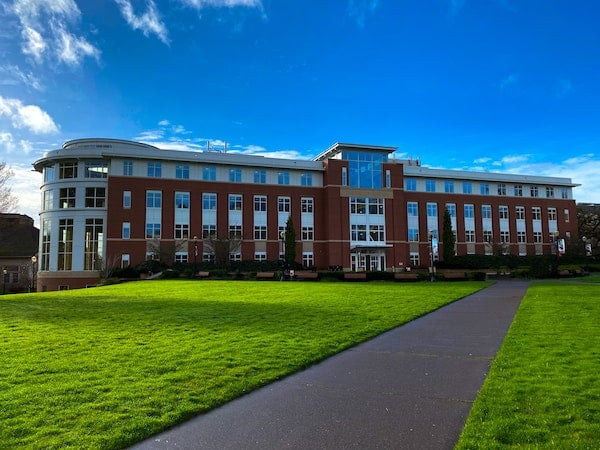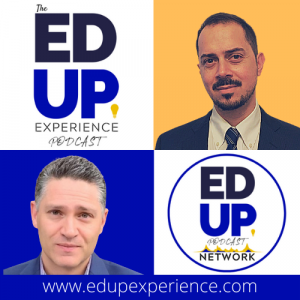Published on
The College President’s 24/7 Commitment

With higher education shaken up from the pandemic, institutions are looking to keep learners at their institution and provide them with the most relevant programming, so they stay competitive in the job market. This also means adapting to their new needs and providing support as needed. In this interview, Dr. Joe Sallustio speaks with Jason Morrison about the current state of higher education, how to be responsive to today’s learners and the responsibilities of a college president during these times.
EdUp Experience: How are you able to keep it all together right now?
Jason Morrison (JM): We’ve seen growth every year even during COVID-19. Of course, we hit a brick wall once the pandemic really hit full force and lost a lot of momentum, but the institution has been growing. We always focus on keeping everyone safe, but as a small, rural two-year college, we do not have the luxury of doing everything virtually. Mainly because our student population would not flourish well in a purely virtual environment.
We did what we had to do to get them on campus to give them the hands-on training and education they need. When you’re a hybrid school, you experience both career and technical transfers. So, we’ve been able to minimize any disruption without bringing any real changes in academic delivery. A blip here and there, but we just work through it. When you’re a small school like us, you just have to address the situation and work through it.
EdUp Experience: What are some initiatives or programs you’re working on to help with student success?
JM: First and foremost, you have to know your students. We are a very diverse two-year college, probably one of the most diverse colleges in the state of Arkansas. And it’s about finding opportunities for students learning from one another. Even if they experience diversity from an external point of view, many of the internal experiences students have are similar. We want to focus on those similar experiences and how everyone can grow together. How can you share your individual experiences with one another to help boost everyone forward?
Having a close-knit college, we create and cultivate that environment where students bring their experiences to the table. That starts at the highest level with how we promote the college, then trickles down to our support offices and into the classroom to cohort-type programs. No matter what we may look like on the outside, the experiences and opportunities we offer define us as and our future.
EdUp Experience: How can institutions be more responsive to upskilling and reskilling learners?
JM: It comes down to knowing the community in which you’re invested and what’s impacting its economic growth. Economically speaking, you often hear talk about new businesses. Most economic growth in a state happens through the expansion of current businesses, and we are seeing that, in our area, we have right probably 300 positions available. I see it as the college’s responsibility to go beyond the typical community college service area and attract students from all over who may want to come to the area for a pathway to a career.
We must start investing in two-year colleges and stop treating two-year college students like they’re second-class citizens. They’re making a commitment to go to a two-year college because they want a career in technical profession, or they’re starting a two-year college to transfer to a four-year university. We have to stop treating them like they don’t deserve the full college experience.
EdUp Experience: How do you succeed, especially in today’s environment?
JM: All students need to find where they fit. Every student has a different environmental fit; they just need to find the one in which they will succeed. They also have to find a profession or a career they will enjoy. We have to do a better job of matching a student’s passion with a valuable career. That’s where the institution has potential for success—when students are in programs in which they are proud to be . The more invested in the program, the more successful they’ll be.
If I got a trophy, I was always asked, “How can you improve? How can you be better? Where were your mistakes? What can you do to advance the team, not just yourself as an individual?” And I hope we’re instilling that mindset here at ASU Tech.
It’s your area. It’s your ownership. I need to know how you want to do it, how you’re going to invest, how you’re going to advance your area because you cannot depend on me all the time to provide you with the answers. You need to have the answers. You need to learn and develop as a leader.
Even students need to learn and develop to find their own answers and not depend on anyone else. I’m more focused on developing those leaders and their empowerment in decision-making. If they make a wrong decision, we can usually fix them pretty easily. I’d rather be making wrong decisions and move forward than be so hesitant and play so safe that I’m unwilling to make a decision or put myself out there. I want to help cultivate the future of higher education.
EdUp Experience: There’s always been a stigma around community colleges. If higher ed is really for all, then it better be affordable for all. Are community colleges are filling that space?
JM: You’re going to see a lot of geographical differences when it comes to some areas a little bit further along than others. The birth of community college systems came in 1991, so depending on your state and its economical and geographical factors, some areas still all have a “four-year or die” mentality.
So, you have to deal with varied dynamics based on different areas. The tide is turning, but we are still educating counsellors and so forth about the value of two-year colleges and saving money. Some students are a little savvier when it comes to the economics and affordability of two-year colleges, but we can only grow that group if we see greater equitability in funding. There has to be, at the top level, a greater investment in federal and state dollars because not all community colleges have a local tax and revenue base.
EdUp Experience: Is there anything you’d like to add?
JM: First, as far as our institution goes, I’m so proud of what our people have accomplished. We’ve had about $25 million in investments given our schools that have not been attributed to direct increase or just state funding.
The worst thing community colleges do is duplicate another school’s program. Be your own self. Come up with your own ideas. Find your own niche that you can serve. When I got here, we hit the ground running.
It’s the culmination of great success because of the talent we had on the ground. And sometimes it comes down to finding talents you didn’t realize you had. We will continue to fight for the advancement of our foundation. You need to promote yourself and sell yourself as an institution. You need got to be exciting. You need to be relevant to your industries and your community.
EdUp Experience: What does the future of higher education look like?
JM: When it comes to the future of higher education, there are some things I’m concerned about. I hope we don’t just jump all in on this idea that everything can be done virtually from a distance. We’re missing out on the investment of human emotion and interaction. Students who do not have reliability will fall behind. That’s not to say virtual technology is not great—it is. But I believe in synchronous, live moments during which we can interact. We cannot lose sight of the value of interacting with one another.
This interview was edited for length and clarity.
Disclaimer: Embedded links in articles don’t represent author endorsement, but aim to provide readers with additional context and service.



